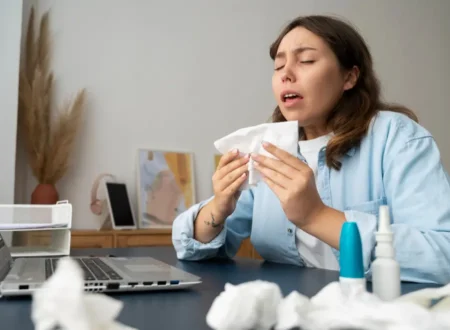How to Get Rid of the Flu at Home:
The flu, or influenza, is a common viral infection that can leave you feeling weak, fatigued, and uncomfortable. Knowing how to get rid of the flu at home is crucial for a speedy recovery and avoiding unnecessary complications. With the right combination of rest, hydration, nutrition, and simple remedies, you can effectively manage flu symptoms without leaving your home. This article provides practical methods to help you regain your health and feel better faster. Read on to discover how these proven strategies can make a difference.
Method 1: Rest and Recharge Your Body
Resting is one of the most critical steps in combating the flu. At the point when you’re contaminated, your body endeavors to battle the infection, and rest gives you the energy it requires to productively recuperate.
The Science Behind Rest:
When you sleep, your immune system releases proteins called cytokines, which play a key role in fighting infections and reducing inflammation. A lack of sleep can lower cytokine production, slowing recovery.
How to Rest Effectively:
- Prioritize Sleep: Aim for 8-10 hours of uninterrupted sleep each night to help your body heal.
- Take Frequent Breaks: Short naps during the day (20–30 minutes) can help restore your energy levels.
- Create a Comfortable Environment: Use soft pillows, keep your room dark, and maintain a cool but cozy temperature to encourage restful sleep.
Avoid engaging in strenuous activities or work that might tax your energy reserves. Letting your body rest allows the immune system to focus entirely on fighting the virus.

Method 2: Stay Hydrated
Dehydration is a common problem during the flu, especially if you’re experiencing fever, sweating, or reduced fluid intake. Staying hydrated is crucial for maintaining body function and alleviating flu symptoms.
Benefits of Hydration:
- Mucus Thinning: Helps to keep mucus thin and easier to expel, reducing nasal congestion.
- Regulates Temperature: Drinking fluids aids in controlling your body temperature, especially when fever is present.
- Improves Energy Levels: Prevents fatigue caused by dehydration.
What to Drink:
- Water: Sip water frequently throughout the day to stay consistently hydrated.
- Electrolyte Drinks: Drinks like coconut water or sports beverages help replenish electrolytes lost through sweating.
- Herbal Teas: Chamomile, ginger, and peppermint tea are soothing and can alleviate throat discomfort.
- Warm Broths: Chicken or vegetable broth hydrates and provides nutrients to support recovery.
- Fresh Fruit Juices: Orange juice is especially beneficial due to its high vitamin C content, which boosts immunity.

Method 3: Boost Immunity with Nutritious Foods
The food you eat plays a crucial role in speeding up flu recovery. Certain foods strengthen your immune system, help reduce inflammation, and give your body the nutrients it needs to heal.
Immunity-Boosting Foods:
- Vitamin C-Rich Foods: Citrus fruits like oranges, lemons, and grapefruits enhance white blood cell production.
- Garlic and Ginger: Known for their antiviral and anti-inflammatory properties, these ingredients can reduce symptoms and fight infections.
- Probiotics: Yogurt and fermented foods like kimchi and kefir support gut health, which is closely linked to overall immunity.
- Leafy Greens: Spinach, kale, and Swiss chard are high in antioxidants that combat oxidative stress.
- Lean Proteins: Foods like chicken, fish, and eggs repair tissues and maintain strength during recovery.
Meal Suggestions for Flu Recovery:
- Start your day with oatmeal topped with honey, nuts, and a banana.
- Prepare a warm bowl of chicken soup with vegetables for lunch or dinner.
- Snack on yogurt with a drizzle of honey or a handful of berries.
Stay away from seared, handled, or sweet food sources that might cause aggravation and draw out recuperation.

Method 4: Try Natural Home Remedies
Natural remedies are effective for managing flu symptoms and speeding up recovery. They can be easily prepared at home using everyday ingredients.
Steam Inhalation:
Steam inhalation helps clear nasal passages and soothes sinus congestion.
- How to do it: Boil water, pour it into a bowl, and add a few drops of eucalyptus or peppermint oil. Cover your head with a towel and breathe in the steam profoundly for 10 minutes. Repeat 2–3 times a day.
- Saltwater Gargles: Saltwater gargles relieve throat pain and kill bacteria in the mouth and throat.
- How to do it: Dissolve ½ teaspoon of salt in a glass of warm water. Wash for 30 seconds and let it out. Repeat this 3–4 times daily.
Honey and Lemon Tea:
- How to make it: Mix one tablespoon of honey and half a lemon juice in a cup of warm water or herbal tea. Drink two times day to day for the best outcomes.
- Warm Compress use: Absorb a towel with warm water, wring it out, and apply it to sore regions for 15-20 minutes.
These natural remedies provide much-needed relief and complement other flu recovery strategies.

Method 5: Use Over-the-Counter Medications
While natural remedies work well, sometimes flu symptoms require additional relief through over-the-counter (OTC) medications. These medications can target specific symptoms, helping you recover more comfortably.
Types of OTC Medications:
- Pain Relievers and Fever Reducers: Acetaminophen (Tylenol) or ibuprofen (Advil) can reduce fever, headaches, and body aches.
- Cough Suppressants: Dextromethorphan (found in many cough syrups) helps manage dry coughs.
- Expectorants: Guaifenesin loosens mucus and makes it easier to cough up.
- Decongestants: Nasal sprays or oral decongestants like pseudoephedrine relieve nasal blockage.
Guidelines for Use:
- Continuously read the directions cautiously and follow the suggested measurements.
- Avoid combining medications with similar active ingredients to prevent side effects.
- Consult a healthcare provider if you are unsure about the suitability of a particular medication, especially if you have other medical conditions.
OTC medications provide quick relief from flu symptoms, allowing you to rest and recover more effectively.

Additional Tips for Flu Recovery:
- Disinfect Your Surroundings: Regularly clean commonly touched surfaces like doorknobs, remote controls, and phones to prevent the spread of the virus.
- Use a Humidifier: A humidifier adds moisture to the air, relieving nasal congestion and throat irritation.
- Stay Warm: Wear comfortable, warm clothing and use blankets to manage chills.
- Avoid Smoking: Smoking irritates the respiratory system and prolongs flu recovery.
- Practice Good Hygiene: Wash your hands frequently and avoid touching your face to reduce the risk of spreading the virus to others.
Conclusion:
Recovering from the flu doesn’t have to be overwhelming when you know how to get rid of the flu at home. By prioritizing rest, staying hydrated, boosting your immune system with proper nutrition, and using natural and OTC remedies, you can manage symptoms effectively and recover quickly. Creating a clean and comfortable environment further supports your healing process. While home care is often sufficient, don’t hesitate to seek medical help if symptoms worsen. Embrace these strategies to restore your health and prevent future infections.
Remember, while most cases of the flu can be managed at home, it’s important to monitor your symptoms closely. If they worsen or persist beyond a few days, seeking medical attention is crucial to prevent complications. By adopting these strategies and creating a supportive environment, you can recover faster and return to your normal routine feeling stronger and healthier.
Read More: How to Get Rid of Influenza Using These 5 Essential Steps







